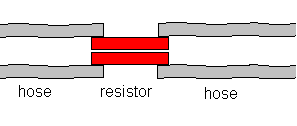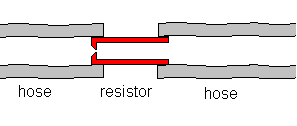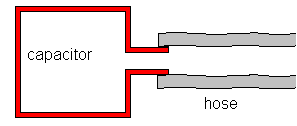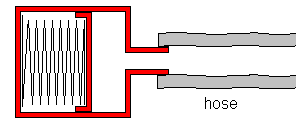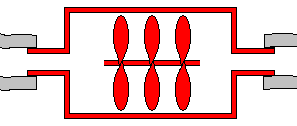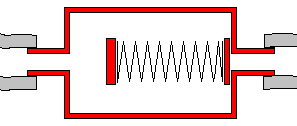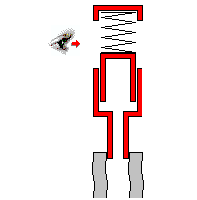Difference between revisions of "Pneumatics"
m (→Elements: some grammar) |
|||
| (3 intermediate revisions by one other user not shown) | |||
| Line 1: | Line 1: | ||
'''Pneumatics''' is a technology for [[automation]]. On [[Mars]] there are many processes to maintain in an artificial habitat, which needs automatic control and alarming. Pneumatics is an alternative to [[electronics]] and can provide exactly the same functionality and precision. | '''Pneumatics''' is a technology for [[automation]]. On [[Mars]] there are many processes to maintain in an artificial habitat, which needs automatic control and alarming. Pneumatics is an alternative to [[electronics]] and can provide exactly the same functionality and precision. | ||
| − | The things we are used to do with electronics are not really bound to the flow of electrons and the creation of [[ | + | The things we are used to do with electronics are not really bound to the flow of electrons and the creation of [[electronics#Semiconductors|semiconductors]]. Complex circuits can be constructed with flowing [[air]] instead of flowing electrons. This technology seems to be almost forgotten, and people tend to think of electronics as the only way of doing automation. On [[Earth]] it is easy to go to the electronics merchant and buy a handful of transistors and rectifiers. But on Mars? The settlers may not be able to build a transistor factory with all the costly technology required for making a transistor out of [[regolith]]. |
| − | The functional elements of pneumatics are made from [[metal]] tubes of different diameter and length, vessels, gaskets from [[synthetic materials]], etc. All this does not require [[hi-tech versus lo-tech|hi-tech]] processes, and hence are easier to [[Equipment for autonomous growth#Reproductive Technology|reproduce]], making it an interesting alternative for automation technology on Mars. | + | The functional elements of pneumatics are made from [[:category:metal|metal]] tubes of different diameter and length, vessels, gaskets from [[synthetic materials]], etc. All this does not require [[hi-tech versus lo-tech|hi-tech]] processes, and hence are easier to [[Equipment for autonomous growth#Reproductive Technology|reproduce]], making it an interesting alternative for automation technology on Mars. |
==Physical basics== | ==Physical basics== | ||
| + | All pneumatics are powered by [[compressed-air]], which can easily be produced, perhaps even [[physical exercise|manually]]. The following list gives a comparison with [[electricity]]: | ||
| + | |||
* Air ''pressure'' is the analogon to electrical ''voltage''. | * Air ''pressure'' is the analogon to electrical ''voltage''. | ||
* ''Flow'' of air is the analogon to electrical ''current'' | * ''Flow'' of air is the analogon to electrical ''current'' | ||
| Line 96: | Line 98: | ||
| − | [[Category: | + | [[Category: Emerging Technologies]] |
Latest revision as of 12:09, 17 December 2018
Pneumatics is a technology for automation. On Mars there are many processes to maintain in an artificial habitat, which needs automatic control and alarming. Pneumatics is an alternative to electronics and can provide exactly the same functionality and precision.
The things we are used to do with electronics are not really bound to the flow of electrons and the creation of semiconductors. Complex circuits can be constructed with flowing air instead of flowing electrons. This technology seems to be almost forgotten, and people tend to think of electronics as the only way of doing automation. On Earth it is easy to go to the electronics merchant and buy a handful of transistors and rectifiers. But on Mars? The settlers may not be able to build a transistor factory with all the costly technology required for making a transistor out of regolith.
The functional elements of pneumatics are made from metal tubes of different diameter and length, vessels, gaskets from synthetic materials, etc. All this does not require hi-tech processes, and hence are easier to reproduce, making it an interesting alternative for automation technology on Mars.
Contents
Physical basics
All pneumatics are powered by compressed-air, which can easily be produced, perhaps even manually. The following list gives a comparison with electricity:
- Air pressure is the analogon to electrical voltage.
- Flow of air is the analogon to electrical current
- An air compressor is the analogon to an electrical voltage source.
- The environmental air pressure is the analogon to the electrical ground.
Elements
There is no limit in size of the elements, they can be scaled up or scaled down, it depends on the situation. The usual size of a pneumatic resistor is about 2 cm long, which is a good size for easy handling. Capacitors are about 4 cm high with a 3 cm diameter, depending on the capacity required.
The elements can be combined to circuits, for example a pneumatic astable multivibrator with optical signal output. Also, there are highly sophisticated PID controllers the size of a foot, made of pure pneumatics. Such circuits have been widely used in automation since the 1980s, especially in factories with dangerous explosive gases.
Resistors
Laminar Flow ResistorThis element has an effect upon flowing air just like a linear electric resistor has upon the flow of electrons. It is built from a metal tube of small diameter. The value of the resistance is linear and depends on the length of the element. |
|
Turbulence Flow ResistorThis element has an effect upon flowing air like a non-linear electric resistor, such as a diode. It is built from a metal tube that is closed at one end with a small puncture. The resistance depends on the flow. |
Capacitors
This element is a vessel that can store an amount of air with more or less high pressure.
Non-Linear CapacitorThis is just an empty vessel. The accumulated air volume is non-linear with the pressure. |
|
Linear CapacitorThe cylindric vessel contains a piston that is held by a spiral spring. The accumulated air volume is linear with the pressure. |
Inductors
|
This element has an effect upon flowing air just like a coil has upon the flow of electrons. It is built from a metal tube of big diameter. The flowing air has a certain inertia, which causes a flow resistance for a little while after the pressure has switched on, and pushes the air forward for a little while after the inital pressure has switched off. A passive turbine inside the tube has an intensifying effect. |
Rectifiers
|
Everybody knows this from a bicycle: The air valves of the wheel tube let the air flow in only one direction. |
Amplifiers
|
There are various pneumatic amplifiers that act like an electronic transistor. |
Signal output
|
For signal output there are optical and acoustical elements. The picture shows an optical output element. |
Use cases
- Automatic sun orientation of mirrors or solar panels for lighting and energy harvesting
- Signalling of failures
- Air pressure control
- Timer for automatic watering in greenhouses
See also
- Hydraulics (e.g. for temperature control)
